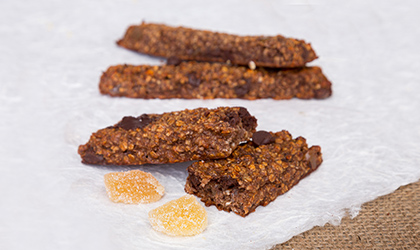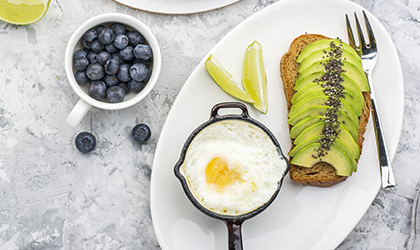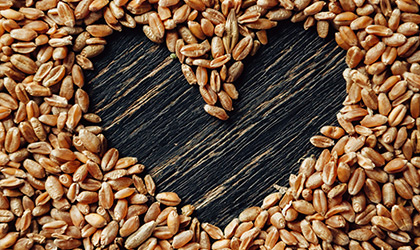
The mention of ‘protein’ may conjure up the well-worn cliché of bodybuilders chowing down on bars and shakes in a bid to bulk up. And while this trope is pretty spot-on, in truth, everyone needs to eat enough protein – about 58 grams each day – to function optimally. Protein is a vitally important macronutrient that excels in many areas of health. Alongside supporting the building blocks of tissues, bones, muscles, skin and blood, this compound plays an essential role in metabolic function and satiety. Hence protein is one of the best weapons in your arsenal to keep you slim, lean and strong.
Okay, so we’ve established you need to eat more protein, but the million-dollar question is how to incorporate it seamlessly into your every day diet. There are only so many chicken sandwiches one can eat, after all! The secret to upping your protein intake is thinking outside this restrictive ‘must-add-meat-box’. The following ideas will highlight how to increase your daily protein consumption without disrupting your usual regimen.
Egg-cellent
Forget that sugary bowl of cereal and swap it for eggs. Scrambled, poached or boiled, eggs are tried-and-tested protein powerhouses, with a large one packing around 7 grams alone! Eating protein for breakfast is always a smart move since it enhances feelings of fullness and will ensure that mid-morning slump doesn’t get the better of you. For truly egg-cellent breakfasts, why not add a sweet pepper, cherry tomatoes or handful of spinach to the mix. Heck, you could go the whole hog with hot sauce and herbs (psst…chives were made for adorning eggs). Pondering which eggs to put in your shopping trolley? Opt for farm-fresh, free-range and organic where possible.
Lots of lovely lentils
Want to increase the protein value of your soups and stews? Listen up. Lentils won’t just bulk out your hearty bowl of broth; they will fill you up with practically no effort at all. Plus, they boast slow-release energy properties, meaning you won’t be tempted to munch on empty calories throughout the day. Brown, yellow, red, green, lentils are a healthy and delicious alternative to the traditional starches you may add to soups, such as rice and noodles. Oh, and did we mention they’re brilliant bang for your buck, too? In many ways, these nutty, earthy fellas could be the best legume going.
Go nuts
Nuts are chock-full of protein, with almonds, cashews, walnuts and pecans boasting the richest content. The real beauty of these little guys is just how versatile they are. Pecans add a delicious crunch to salads, desserts and appetizers, while chopped almonds inject a little pizazz to stir-fried veggies. Craving something sweet? Add a handful of macadamia nuts to your cookies or brownies. Of course, straight-up nuts are the perfect snack when that four o’clock slump strikes. Be sure stash a bag in your office drawer.
…and get nutty about nut butter
We couldn’t mention nuts with singing the praises of nut butter. Health enthusiasts won’t stop waxing lyrical about this creamy, delicious condiment – and it’s not surprising. A dollop of peanut, cashew or almond butter provides a strong hit of protein, as well as heart-healthy fats and antioxidants. Best of all? You can whip up your own jar at home. Simply roast any nut you desire, and then blend for around 10-12 minutes. Add a dash of sea salt if you fancy, but there’s no need for sweeter, oil, or water. Blob a spoonful on porridge, smoothies, yoghurt bowls, fresh fruit (chopped apple and peanut butter is a dream combo), or simply spread on wholegrain toast.
Greetings, Greek yoghurt
Greek yoghurt is another protein-dense champ, and one that pairs perfectly with our nutty friends mentioned above. Besides delivering a ton of bone-bolstering calcium and gut-healthy bacteria, plain Greek yoghurt can deliver up to 20 grams of protein in just one serving. Pretty impressive, right? The only caveat is that you need to become an ingredient sleuth when perusing the yoghurt aisle. Always choose varieties with little to no added sugar. A simple way to dress up this creamy canvas is with berries and fresh fruit. Oh, and Greek yoghurt in your mashed tatters is delicious, too. Don’t knock it till you’ve tried it.
Spice up salads
Salads are the perfect dish to pack with protein. And no, we’re not just talking about ‘adding grilled chicken’ (although, of course, this isn’t a bad choice). Think about spicing up your leaves with a handful of nuts, or – better still – roasted pumpkin seeds, which taste utterly divine. You could even add a sprinkling of nutritional yeast – a firm favourite of vegan diets, thanks to it containing 6 grams of protein per serving. Another quick win: use tahini. Made from sesame paste, tahini is a brilliant alternative to traditional salad dressings because of its noteworthy protein content. It boasts about 2 grams per serving, compared to olive oil’s negligible zero grams. Use fresh lemon juice and a dash of extra virgin olive oil to get the dressing going, and then use mustards, spices and herbs for added zing.
Hummus is where the heart is
Hummus (a.k.a. the best dip ever) is – in our opinion – a true kitchen staple. Brimming with shed loads of plant-based protein and healthy fats, hummus is a wonderful addition to both meals and snacks. In fact, this velvety spread can be used in almost any dish. Serve with celery sticks and carrots, salads, or wholegrain pita. You could even get creative and add it to grilled fish, devilled eggs, or dolloped on soup. Top tip: sprinkle hummus with toasted pumpkin seeds for an extra hit of protein.
Say cheese
Cheese lovers, rejoice: you can now officially ‘cheese it up’ in the name of protein. Huzzah! Sadly, this isn’t an excuse to order an XL four-cheese pizza, though; the harder cheeses tend to have more protein per serving, like Parmesan and Romano. The secret to reaping the protein benefits from cheese is choosing quality, watching quantity, and erring on the side of caution; y want to be saying, “yum, that was delicious’, not “gee, I need to unbuckle my belt”. Cheese was made for sprinkling on salads, eating with grapes and apples, or combining with homemade tomato chutney.
Replace rice with quinoa
Another easy way to pack more protein into your meals? Switch your traditional grains for quinoa. Unlike white rice and couscous, quinoa is overflowing with protein and amino acids that will crank up the nutritional value of your dishes. Plus, its nutty flavour and rougher texture make it all the more delicious. Add quinoa to salads, stews and trendy Buddha bowls. And if you really want to capitalise on the versatility of this grain, use it in breakfast porridge, burger patties and stuffed peppers. For a double whammy of protein power, drizzle a good dollop of tahini over quinoa bowls.
Sprinkle on chia seeds
The simple act of adding chia seeds to meals means you can cram even more protein into your diet. Don’t be fooled by their tiny size – these little guys have truly earned their stripes as a ‘superfood’. In just two tablespoons, chia seeds pack a whopping 4 grams of protein. Not only that, but they’re chock-full of fibre and omega-3 fatty acids, too. Power-up your porridge, smoothies and salads with a sprinkling of these potent fellas. Vegan? Swap eggs for chia seeds and water in your baking.
Invest in quality protein powder
As the name would suggest, protein powder does the job of increasing your protein intake pretty darn well. No time for breakfast? Fear not. A well-balanced protein shake will jumpstart your morning and still get you to work on time. With the addition of fruit, like a banana, a dollop of peanut butter, and a cup of plant-based milk, this brekkie beverage should keep you satisfied until lunch. Protein shakes make for a brilliant afternoon snack, too, as well as fantastic pre and post gym nutrition. For tasty recipes, please click here.
BCAA
BCAA, or Branch Chain Amino Acids, are often associated with protein, especially amongst sports enthusiasts. But what are branched chain amino acids? BCAA amino acids are a group of three essential amino acids: leucine, isoleucine, and valine. These amino acids are particularly important for muscle protein synthesis and are often used by athletes and bodybuilders as a dietary supplement. BCAAs can also be found in various food sources, including meat, dairy products, legumes chickpeas, black beans), and certain grains.
Final thoughts
The importance of eating enough protein really can’t be overstated. Not only does it support countless biological functions, but it assists with satiety, too – meaning it’s a key component to helping you stay slim and lean. In addition to eating more of the protein superstars we’ve mentioned above, try to include one protein source – be it animal or plant-based – with every meal. And make it the VIP (Very Important Protein) of every dish.
You Might Also Like

Keri
Keri Filtness has worked in the Nutrition Industry for 19 years. She is regularly called upon for her professional comments on health and nutrition related news. Her opinions have been featured by BBC3, Prima, Vitality, The Mirror, Woman’s Own and Cycling Weekly, amongst others. She has also worked one to one with journalists, analysing their diets and health concerns and recommending changes and additions, where appropriate.
View More






